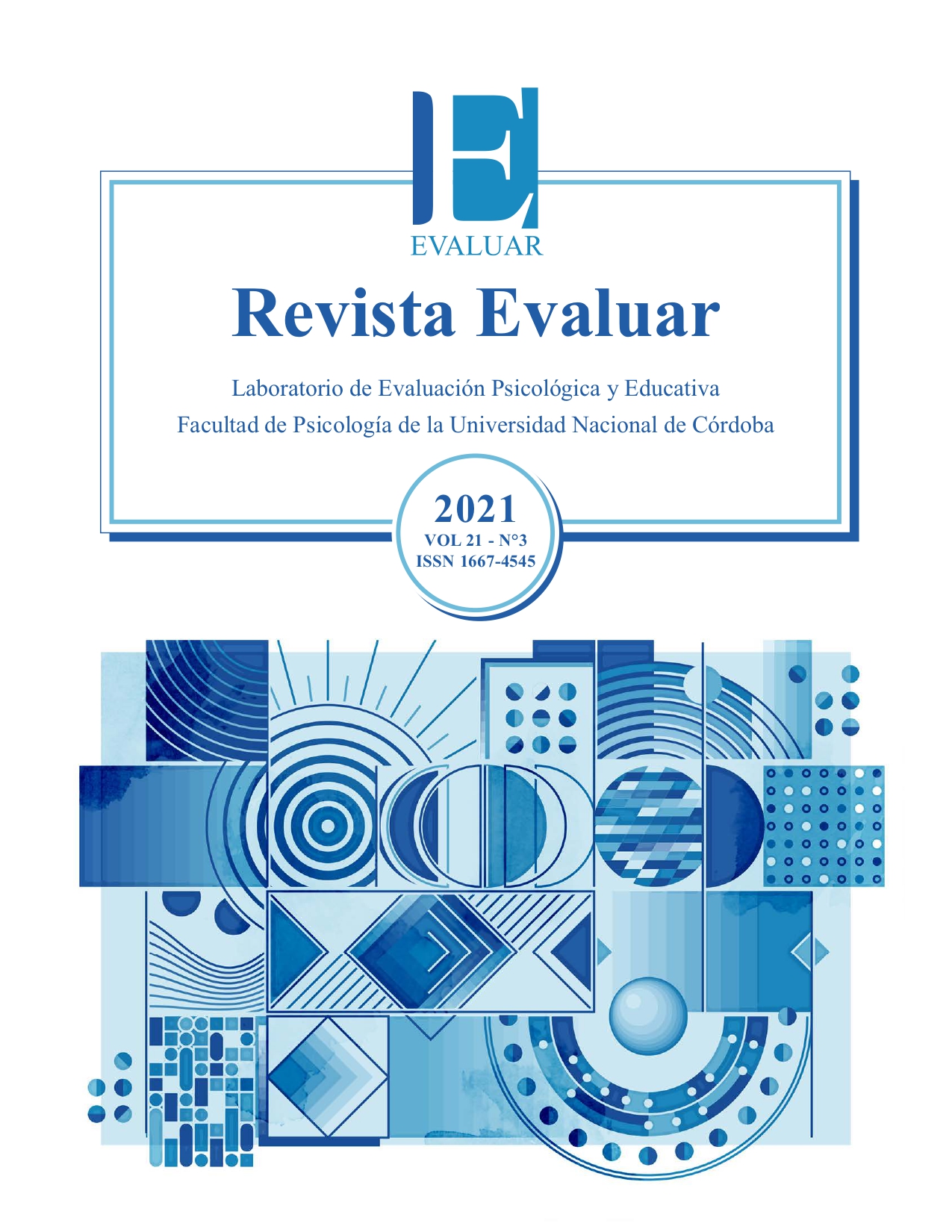BifactorCalc: An Online Calculator for Ancillary Measures of Bifactor Models
DOI:
https://doi.org/10.35670/1667-4545.v21.n3.36272Keywords:
software, bifactor, SEM, calculator, auxiliary measuresAbstract
The bifactor model allows examining the presence of a total score in a data set by modeling a general factor and two or more specific factors with an orthogonal relationship. These models tend to overestimate the goodness of fit (e.g., CFI, RMSEA, SRMR), hence there exist auxiliary measures that allow examining the dimensionality (ECVGen; ECVSpecific; I-ECV, PUC, ARPB), and reliability (ω, ωS, ωH, ωHS, PRV, H, and FD). The present study describes the operation, mathematical foundations, and application in psychological research of an online calculator called BifactorCalc. The results demonstrate that BifactorCalc is an online, user-friendly, and easy-to-use computer program for the calculation of the different auxiliary measures of bifactor models. It was concluded that the computer tool BifactorCalc is able to calculate the auxiliary measures of bifactor models in three simple steps and generate a path diagram.
Downloads
References
Anderson, A. E., & Marcus, D. K. (2019). A bifactor model of meanness, coldheartedness, callousness, and sadism. Personality and Individual Differences, 137, 192-197. doi: 10.1016/j.paid.2018.09.006
Beauducel, A. (2011). Indeterminacy of factor score estimates in slightly misspecified confirmatory factor models. Journal of Modern Applied Statistical Methods, 10(2), 583-598. doi: 10.22237/jmasm/1320120900
Bonifay, W., Lane, S. P., & Reise, S. P. (2017). Three concerns with applying a bifactor model as a structure of psychopathology. Clinical Psychological Science, 5(1), 184-186. doi: 10.1177/2167702616657069
Burns, G. L., Geiser, C., Servera, M., Becker, S. P., & Beauchaine, T. P. (2019). Application of the bifactor S-1 model to multisource ratings of ADHD/ODD symptoms: An appropriate bifactor model for symptom ratings. Journal of Abnormal Child Psychology, 48(7), 881-894. doi: 10.1007/s10802-019-00608-4
Canivez, G. L. (2016). Bifactor modeling in construct validation of multifactored tests: Implications for understanding multidimensional constructs and test interpretation. In K. Schweizer & C. DiStefano (Eds.), Principles and Methods of Test Construction: Standards and Recent Advancements (pp. 247-271). Gottingen, Germany: Hogrefe Publishers.
Cicchetti, D. V. (1994). Guidelines, criteria, and rules of thumb for evaluating normed and standardized assessment instruments in psychology. Psychological Assessment, 6(4), 284-290.
DeMars, C. E. (2013). A tutorial on interpreting bifactor model scores. International Journal of Testing, 13(4), 354-378. doi: 10.1080/15305058.2013.799067
DiStefano, C., Zhu, M., & Mîndrilǎ, D. (2009). Understanding and using factor scores: Considerations for the applied researcher. Practical Assessment, Research and Evaluation, 14. Retrieved from https://scholarworks.umass.edu/pare
Django Software Foundation. (2019). Django. Retrieved from https://djangoproject.com
Dominguez-Lara, S. (2016). Evaluación de la confiabilidad del constructo mediante el Coeficiente H: Breve revisión conceptual y aplicaciones. Psychologia. Avances de la Disciplina, 10(2), 87-94. doi: 10.21500/19002386.2134
Dominguez-Lara, S., & Rodriguez, A. (2017). Índices estadísticos de modelos bifactor. Interacciones. Revista de Avances en Psicología, 3(2), 59-65. doi: 10.24016/2017.v3n2.51
Dueber, D. M. (2017). Bifactor Indices Calculator: A Microsoft Excel-based tool to calculate various indices relevant to bifactor CFA models. doi: 10.13023/edp.tool.01
Dueber, D. M. (2020). Package ‘BifactorIndicesCalculator’. Retrieved from https://github.com/ddueber/BifactorIndicesCalculator
Dunn, T. J., Baguley, T., & Brunsden, V. (2013). From alpha to omega: A practical solution to the pervasive problem of internal consistency estimation. British Journal of Psychology, 105(3), 399-412. doi: 10.1111/bjop.12046
Eid, M., Geiser, C., Koch, T., & Heene, M. (2017). Anomalous results in G-factor models: Explanations and alternatives. Psychological Methods, 22(3), 541-562. doi: 10.1037/met0000083
Ferrando, P. J., & Lorenzo-Seva, U. (2017). Assessing the quality and appropriateness of factor solutions and factor score estimates in exploratory item factor analysis. Educational and Psychological Measurement, 78(5), 762-780. doi: 10.1177/0013164417719308
Flores-Kanter, P. E., Dominguez-Lara, S., Trógolo, M. A., & Medrano, L. A. (2018). Best practices in the use of bifactor models: Conceptual grounds, fit indices and complementary indicators. Revista Evaluar, 18(3). doi: 10.35670/1667-4545.v18.n3.22221
Gignac, G. E. (2008). Higher-order models versus direct hierarchical models: g as superordinate or breadth factor? Psychology Science, 50(1), 21-43.
Gorsuch, R. L. (1983). Two-and three-mode factor analysis. In R. L. Gorsuch (Ed.), Factor Analysis (2nd ed.). Hillsdale, NJ: Erlbaum.
Grice, J. W. (2001). Computing and evaluating factor scores. Psychological Methods, 6(4), 430-450. doi: 10.1037/1082-989x.6.4.430
Gustafsson, J.-E., & Balke, G. (1993). General and specific abilities as predictors of school achievement. Multivariate Behavioral Research, 28(4), 407-434. doi: 10.1207/s15327906mbr2804_2
Hammer, J. H., McDermott, R. C., Levant, R. F., & McKelvey, D. K. (2018). Dimensionality, reliability, and validity of the Gender-Role Conflict Scale-Short Form (GRCS-SF). Psychology of Men & Masculinity, 19(4), 570-583.
Harris, C. R., Millman, K. J., van der Walt, S. J., Gommers, R., Virtanen, P., Cournapeau, D., ... Oliphant, T. E. (2020). Array programming with NumPy. Nature 585, 357-362. doi: 10.1038/s41586-020-2649-2
Heinrich, M., Zagorscak, P., Eid, M., & Knaevelsrud, C. (2018). Giving G a meaning: An application of the Bifactor-(S-1) approach to realize a more symptom-oriented modeling of the Beck Depression Inventory-II. Assessment, 27(7), 1429-1447. doi: 10.1177/1073191118803738
Holzinger, K. J., & Swineford, F. (1937). The bi-factor method. Psychometrika, 2(1), 41-54. doi: 10.1007/bf02287965
Li, C. (2015). The short Grit scale: A dimensionality analysis (Tesis de maestría). University of Kentucky, EE.UU. Retrieved from http://uknowledge.uky.edu/edp_etds/33
McDonald, R. P. (2013). Test theory: A unified treatment. New York: Psychology Press. doi: 10.4324/9781410601087
Montes, S. A., & Sanchez, R. O. (2019). El factor p. ¿La estructura subyacente a la psicopatología? Revista Evaluar, 19(3), 20-41. doi: 10.35670/1667-4545.v19.n3.26774
Morgan, G. B., Hodge, K. J., Wells, K. E., & Watkins, M. W. (2015). Are fit indices biased in favor of bi-factor models in cognitive ability research?: A comparison of fit in correlated factors, higher-order, and bi-factor models via Monte Carlo simulations. Journal of Intelligence, 3(1), 2-20. doi: 10.3390/jintelligence3010002
Mueller, R. O., & Hancock, G. R. (2008). Best practices in structural equation modeling. In J. Osborne (Ed.), Best Practices in Quantitative Methods (pp. 488-508). Thousand Oaks, California: Sage.
R Core Team. (2020). R: A language and environment for statistical computing. R Foundation for Statistical Computing. Vienna, Austria. Retrieved from https://www.R-project.org
Reise, S. P. (2012). The rediscovery of bifactor measurement models. Multivariate Behavioral Research, 47(5), 667-696. doi: 10.1080/00273171.2012.715555
Reise, S. P., Bonifay, W. E., & Haviland, M. G. (2013). Scoring and modeling psychological measures in the presence of multidimensionality. Journal of Personality Assessment, 95(2), 129-140. doi: 10.1080/00223891.2012.725437
Reise, S. P., Moore, T. M., & Haviland, M. G. (2010). Bifactor models and rotations: Exploring the extent to which multidimensional data yield univocal scale scores. Journal of Personality Assessment, 92(6), 544-559. doi: 10.1080/00223891.2010.496477
Reise, S. P., Moore, T. M., & Haviland, M. G. (2013). Applying unidimensional item response theory models to psychological data. In K. F. Geisinger, B. A. Bracken, J. F. Carlson, J.-I. C. Hansen, N. R. Kuncel, S. P. Reise & M. C. Rodriguez (Eds.), APA Handbook of Testing and Assessment in Psychology, Vol. 1. Test theory and testing and assessment in industrial and organizational psychology (pp. 101-119). American Psychological Association. doi: 10.1037/14047-006
Reise, S. P., Scheines, R., Widaman, K. F., & Haviland, M. G. (2013). Multidimensionality and structural coefficient bias in structural equation modeling: A bifactor perspective. Educational and Psychological Measurement, 73(1), 5-26. doi: 10.1177/0013164412449831
Rodriguez, A., Reise, S. P., & Haviland, M. G. (2015). Applying bifactor statistical indices in the evaluation of psychological measures. Journal of Personality Assessment, 98(3), 223-237. doi: 10.1080/00223891.2015.1089249
Rodriguez, A., Reise, S. P., & Haviland, M. G. (2016). Evaluating bifactor models: Calculating and interpreting statistical indices. Psychological Methods, 21(2), 137-150. doi: 10.1037/met0000045
Smits, I. A., Timmerman, M. E., Barelds, D. P., & Meijer, R. R. (2014). The Dutch symptom checklist-90-revised. European Journal of Psychological Assessment, 31(4), 263-271.
Stucky, B. D., & Edelen, M. O. (2014). Using hierarchical IRT models to create unidimensional measures from multidimensional data. In S. P. Reise & D. A. Revicki (Eds.), Handbook of Item Response Theory Modeling: Applications to Typical Performance Assessment (1st ed., pp. 183-206).
Stucky, B. D., & Edelen, M. O. (2014). Using hierarchical IRT models to create unidimensional measures from multidimensional data. In S. P. Reise & D. A. Revicki (Eds.), Handbook of Item Response Theory Modeling: Applications to Typical Performance Assessment, 183-206. Routledge/Taylor & Francis Group.
Vuyk, M. A., & Codas, G. (2019). Validación de la Escala de Esperanza Disposicional para Adultos en Paraguay. Revista Evaluar, 19(1), 59-71. doi: 10.35670/1667-4545.v19.n1.23880
Yap, S. C. Y., Donnellan, M. B., Schwartz, S. J., Kim, S. Y., Castillo, L. G., Zamboanga, B. L., … & Vazsonyi, A. T. (2014). Investigating the structure and measurement invariance of the Multigroup Ethnic Identity Measure in a multiethnic sample of college students. Journal of Counseling Psychology, 61(3), 437-446. doi: 10.1037/a0036253
Downloads
Published
How to Cite
Issue
Section
License
Copyright (c) 2021 José Ventura-León, Luis Quiroz-Burga, Tomás Caycho-Rodríguez, Pablo Valencia

This work is licensed under a Creative Commons Attribution 4.0 International License.
Revista Evaluar aplica la Licencia Internacional de Atribuciones Comunes Creativas (Creative Commons Attribution License, CCAL). Bajo esta licencia, los autores retienen la propiedad de copyright de los artículos pero permiten que, sin que medie permiso de autor o editor, cualquier persona descargue y distribuya los artículos publicados en Evaluar. La única condición es que siempre y en todos los casos se cite a los autores y a la fuente original de publicación (i.e. Evaluar). El envío de artículos a Evaluar y la lectura de los mismos es totalmente gratuito.




_(3).jpg)



.jpg)



